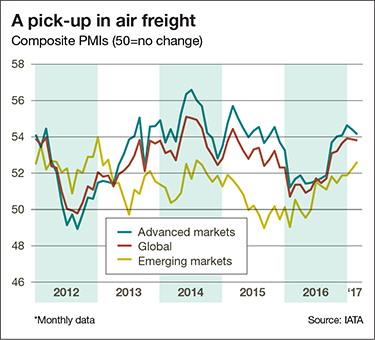2017 State of Logistics: Air Cargo
Volume growth finally beginning to take off

One of the most positive developments for logistics managers so far this year has been the reversal of fortunes in the air cargo sector.
According to the International Air Transport Association (IATA), air cargo markets worldwide showed that demand rose 8.5% in April 2017 compared to the same period a year ago. While this was down from the 13.4% year-on-year growth recorded in March 2017, it is well above the average annual growth rate of 3.5% over the past five years.
“Demand eased in April,” observes Alexandre de Juniac, IATA’s director general and CEO. “Growth rates, however, are still much more robust than anything we have seen in the last six years.”
And while that’s good news, de Juniac adds that there’s room for improvement, particularly in adapting to new technologies. “The industry’s antiquated processes need modernization,” he says. “With e-air waybill utilization topping 50% in April, progress is being made. Now we must harness the momentum to drive transformational change across the way the industry operates.”
Meanwhile, IATA says business confidence indicators remain consistently upbeat, suggesting year-on-year cargo growth will remain strong through the summer. There are signs, however, that the cyclical growth peak for air cargo has passed, particularly given that the inventory-to-sales ratio stopped falling at the end of last year.
IATA analysts note that air cargo often sees a boost in demand at the beginning of an economic upturn, as companies look to restock inventories quickly. This tapers as inventories are adjusted to new demand levels. Over the whole year, IATA says that air cargo is headed for a healthy growth rate of 7.5%, supported by strong pharmaceuticals and e-commerce.
All regions, with the exception of Latin America, reported year-on-year increases in demand so far in 2017. However, Asia-Pacific airlines’ freight volumes were especially healthy, expanding by 8.4% in April 2017 compared to the same period a year earlier. The increase in volumes reflects the strength of the order books reported by exporters across the region.
Cargo volume figures released by the Association of Asia Pacific Airlines (AAPA) confirm these observations, suggesting that business conditions continued to improve across Asian economies, in turn lending support to international trade activity.
 “The broad-based expansion in global economic activity, coupled with renewed demand on selected routes, particularly between Europe and Asia, has contributed to growth in long-haul markets in recent months,” says Andrew Herdman, AAPA director general. Within the same period, Asian airlines recorded a solid 9.5% increase in air cargo demand, supported by a pick-up in export orders across the region’s economies.
“The broad-based expansion in global economic activity, coupled with renewed demand on selected routes, particularly between Europe and Asia, has contributed to growth in long-haul markets in recent months,” says Andrew Herdman, AAPA director general. Within the same period, Asian airlines recorded a solid 9.5% increase in air cargo demand, supported by a pick-up in export orders across the region’s economies.
And over the long term, it may only get better, says John Leahy, chief operating officer for Airbus. He maintains that air traffic continues to prove its resilience to slow economic growth by outperforming global GDP, demonstrating the world’s appreciation of the benefits aviation brings.
“For the next 20 years, the Airbus Global Market Forecast predicts a 4.4% global annual air traffic growth, despite some downward revision of future economic growth by a number of forecasters in several regions of the world,” says Leahy.
Read the full 2017 State of Logistics report here.

Article Topics
Magazine Archive News & Resources
Latest in Materials Handling
Registration open for Pack Expo International 2024 Walmart chooses Swisslog AS/RS and software for third milk processing facility NetLogistik partners with Vuzix subsidiary Moviynt to offer mobility solutions for warehouses Materials Handling Robotics: The new world of heterogeneous robotic integration BSLBATT is looking for new distributors and resellers worldwide Lucas Watson appointed CSO for Körber’s Parcel Logistics business in North America Hyster recognizes Dealers of Distinction for 2023 More Materials HandlingAbout the Author
Subscribe to Materials Handling Magazine

Find out what the world's most innovative companies are doing to improve productivity in their plants and distribution centers.
Start your FREE subscription today.
April 2024 Modern Materials Handling

Latest Resources










